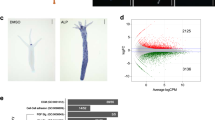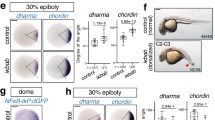Abstract
The Spemann organizer of the amphibian embryo can be subdivided into two discrete activities, namely trunk organizer and head organizer1. Several factors secreted from the organizer that are involved in trunk organization are thought to act by repressing Bmp signalling2,3,4. With the exception of the secreted factor cerberus5, little is known about head-organizer inducers. Here we show that co-expression of a dominant-negative Bmp receptor with inhibitors of the Wnt-signalling pathway in Xenopus leads to the induction of complete secondary axes, including a head. This induction does not require expression of the siamois marker of Nieuwkoop centre signalling, suggesting that cells are directly shifting to head-organizer fate. Furthermore, we find that cerberus is a potent inhibitor of Wnt signalling. Our results indicate that head-organizer activity results from the simultaneous repression of Bmp and Wnt signalling and they suggest a mechanism for region-specific induction by the organizer.
This is a preview of subscription content, access via your institution
Access options
Subscribe to this journal
Receive 51 print issues and online access
$199.00 per year
only $3.90 per issue
Buy this article
- Purchase on Springer Link
- Instant access to full article PDF
Prices may be subject to local taxes which are calculated during checkout


Similar content being viewed by others
References
Gerhart, J., Doniach, T. & Steward, R. in Gastrulation (eds Keller, R., Clark, W. H. & Griffin, F.) 57–77 (Plenum, New York, (1991)).
De Robertis, E. M. & Sasai, Y. Acommon plan for dorsoventral patterning in Bilateria. Nature 380, 37–40 (1996).
Lemaire, P. & Kodjabachian, L. The vertebrate organizer: structure and molecules. Trends Genet. 12, 525–531 (1996).
Hemmati-Brivanlou, A. & Melton, D. Vertebrate embryonic cells will become nerve cells unless told otherwise. Cell 88, 13–17 (1997).
Bouwmeester, T., Kim, S.-H., Sasai, Y., Lu, B. & De Robertis, E. M. Cerberus is a head-inducing secreted factor expressed in the anterior endoderm of Spemann's organizer. Nature 382, 595–601 (1996).
Sokol, S. Y. Analysis of dishevelled signalling pathways during Xenopus development. Curr. Biol. 6, 1456–1467 (1996).
Wang, S., Krinks, M., Lin, K., Luyten, F. P. & Moos, M. Frzb, a secreted protein expressed in the Spemann organizer, binds and inhibits Wnt-8. Cell 88, 757–766 (1997).
Leyns, L., Bouwmeester, T., Kim, S.-H., Piccolo, S. & De Robertis, E. M. Frzb-1 is a secreted antagonist of wnt-signals expressed in the Spemann organizer. Cell 88, 747–756 (1997).
Hoppler, S., Brown, J. D. & Moon, R. T. Expression of a dominant-negative wnt blocks induction of MyoD in Xenopus embryos. Genes Dev. 10, 2805–2817 (1996).
Miller, J. & Moon, R. T. Signal transduction through beta-catenin and specification of cell fate during embryogenesis. Genes Dev. 10, 2527–2539 (1996).
Christian, J. L. & Moon, R. T. Interactions between Xwnt-8 and Spemann organizer signaling pathways generate dorsoventral pattern in the embryonic mesoderm of Xenopus. Genes Dev. 7, 13–28 (1993).
Graff, J. M., Thies, R. S., Song, J. J., Celeste, A. J. & Melton, D. A. Studies with a Xenopus BMP receptor suggest that ventral mesoderm-inducing signals override dorsal signals in vivo. Cell 79, 169–179 (1994).
Suzuki, A. et al. Atruncated bone morphogenetic protein receptor affects dorsal-ventral patterning in the early Xenopus embryo. Proc. Natl Acad. Sci. USA 91, 10255–10259 (1994).
Smith, W. C. & Harland, R. M. Expression cloning of noggin, a new dorsalizing factor localized to the Spemann organizer in Xenopus embryos. Cell 70, 829–840 (1992).
Carnac, G., Kodjachbachian, L., Gurdon, J. B. & Lemaire, P. The homeobox gene siamois is a target of the wnt dorsalization pathway and triggers organiser activity in the absence of mesoderm. Development 122, 3055–3065 (1996).
Sokol, S., Christian, J. L., Moon, R. T. & Melton, D. A. Injected Wnt RNA induces a complete body axis in Xenopus embryos. Cell 67, 741–752 (1991).
Smith, W. C. & Harland, R. M. Injected Xwnt-8 RNA acts early in Xenopus embryos to promote formation of a vegetal dorsalizing center. Cell 67, 753–765 (1991).
Blitz, I. L. & Cho, K. W. Y. Anterior neuroectoderm is progressively induced during gastrulation: the role of the Xenopus homeobox gene orthodenticle. Development 121, 993–1004 (1995).
Pannese, M. et al. The Xenopus homologue of Otx2 is a maternal homeobox gene that demarcates and specifies anterior body regions. Development 121, 707–720 (1995).
Cho, K. W., Blumberg, B., Steinbeisser, H. & De Robertis, E. M. Molecular nature of Spemann's organizer: the role of the Xenopus homeobox gene goosecoid. Cell 67, 1111–1120 (1991).
Taira, M., Jamrich, M., Good, P. J. & Dawid, I. B. The LIM domain-containing homeobox gene Xlim-1 is expressed specifically in the organizer region of Xenopus gastrula embryos. Genes Dev. 6, 356–366 (1992).
Smith, J. C., Price, B. M., Green, J. B., Weigel, D. & Herrmann, B. G. Expression of a Xenopus homolog of Brachyury (T) is an immediate-early response to mesoderm induction. Cell 67, 79–87 (1991).
Itoh, K., Tang, T. L., Neel, B. G. & Sokol, S. Y. Specific modulation of ectodermal cell fates in Xenopus embryos by glycogen synthase kinase. Development 121, 3979–3988 (1995).
Gawantka, V., Delius, H., Hirschfeld, K., Blumenstock, C. & Niehrs, C. Antagonizing the Spemann organizer: role of the homeobox gene Xvent-1. EMBO J. 14, 6268–6279 (1995).
Sasai, Y. et al. Xenopus chordin: a novel dorsalizing factor activated by organizer-specific homeobox genes. Cell 79, 779–790 (1994).
Hemmati-Brivanlou, A., Kelly, O. G. & Melton, D. A. Follistatin, an antagonist of activin, is expressed in the Spemann organizer and displays direct neuralizing activity. Cell 77, 283–295 (1994).
Glinka, A., Delius, H., Blumenstock, C. & Niehrs, C. Combinatorial signalling by Xwnt-11 and Xnr3 in the organizer epithelium. Mech. Dev. 60, 221–231 (1996).
Rupp, R. A., Snider, L. & Weintraub, H. Xenopus embryos regulate the nuclear localization of XMyoD. Genes Dev. 8, 1311–1323 (1994).
Niehrs, C., Steinbeisser, H. & De Robertis, E. M. Mesodermal patterning by a gradient of the vertebrate homeobox gene goosecoid. Science 263, 817–820 (1994).
Gammil, L. S. & Sive, H. Identification of otx2 target genes and restrictions in ectodermal competence during cement gland formation. Development 124, 471–481 (1996).
Acknowledgements
We thank R. Harland, R. Moon, S. Sokol and M. Ueno for constructs, and P. Monaghan for critically reading the manuscript. This work was supported by the DFG.
Author information
Authors and Affiliations
Corresponding author
Rights and permissions
About this article
Cite this article
Glinka, A., Wu, W., Onichtchouk, D. et al. Head induction by simultaneous repression of Bmp and Wnt signalling in Xenopus . Nature 389, 517–519 (1997). https://doi.org/10.1038/39092
Received:
Accepted:
Issue Date:
DOI: https://doi.org/10.1038/39092
This article is cited by
-
Loss of noggin1, a classic embryonic inducer gene, in elasmobranchs
Scientific Reports (2024)
-
Discovery of four Noggin genes in lampreys suggests two rounds of ancient genome duplication
Communications Biology (2020)
-
Diversification of amphioxus and vertebrate Cerberus protein function in modulating Nodal, BMP and Wnt signals
Marine Life Science & Technology (2020)
-
Pluripotent Stem Cells as Models of Retina Development
Molecular Neurobiology (2019)
-
Cancer cell specific inhibition of Wnt/β-catenin signaling by forced intracellular acidification
Cell Discovery (2018)
Comments
By submitting a comment you agree to abide by our Terms and Community Guidelines. If you find something abusive or that does not comply with our terms or guidelines please flag it as inappropriate.



